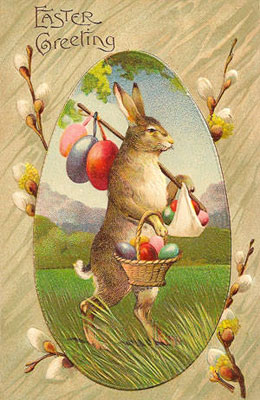
The Rabbit and the Eggs-By Angelique Duncan
Wonderful Enchanted Springtime! Finally the sun and warmth make their appearance after the long slumber of winter. Everything is born again as green and colors emerge from the earthen garden. Celebrations for spring and her Equinox commence as Easter and Oestara announce the arrival of the Easter Bunny, also known as the rabbit Oshter Haws, bringing the gift of colored eggs.
The modern practice and symbolism of “Easter” eggs has existed for many centuries in varying cultures as far back as the Egyptians and Mediterraneans. Throughout time the practice of painting and giving decorative eggs has, for the most part, remained intact in observance. However the interpretive meaning behind the symbolism of eggs has changed. The appearance of painted eggs, or pysanka as they have been named in the Ukraine, at or near the Vernal Equinox is a deep-rooted tradition in many cultures yet has for the most part held the same meaning. Eggs have been used as symbols of rebirth and renewal. In pre-Christian cultures this renewal and rebirth was in celebration of the coming of spring and the renewal of life that occurred in nature. For many Pagan cultures the process of decorating the egg was a ritual and rite of Spring celebration. It was believed that the eggs were endowed with talisman or magical power through prayer and meditation. It was believed the eggs could ward off evil spirits, guarantee a good harvest and bring a person good luck. These meditations passed into the eggs a wish that the recipient would receive protection from harm as well as good fortune and a message of well-being, happiness and joy. With the rise of Christianity the amulet properties of painted eggs was shed and the emphasis of rebirth of nature was shifted to the renewal and redemption of souls through Christ and the resurrection. However the springtime images have remained a prominent theme to most ornamented eggs.
The Easter Rabbit or once named in Germanic culture “Oschter Haws” meaning magical hare was brought to the United States by the Deutsch. The Easter Bunny has his origins as a symbol of renewal of life and fertility in nature. Many believed the rabbit would bring the decorated eggs to well deserving children as rewards in the form of tokens of good fortune for the upcoming year. The Easter rabbit was once revered as a powerful symbol to promote life and fertility for crops, families and livestock. It was believed the hare, being the most prolific in its reproduction during spring, was the most endowed of animals in the process of life renewal from winter to spring. As with the Egg, the Rabbits symbolism was transferred to a more Christian interpretation as Christianity spread and the practice of nature religions declined. The once important fertility symbol of the robust rabbit hare began to lean towards that of the sweet young bunny and became a symbol of the sacrifice Christ made for innocence and the emphasis was less on the rabbits breeding ability and shifted its representation to the “new life” given to the world by Christ. Many non-Christians “accepted” the Christian meaning given to their spring symbols in an effort to preserve pieces of their culture and continue some form of their spiritual practices.
The legend of the magical Oschter Haws or Easter Bunny who delivers enchanted painted eggs under the cover of darkness before sunrise still remains all these centuries later. When you wake up and find those colorful eggs that appeared in your yard early Easter morn and your enjoying those colorfully wrapped chocolates count yourself lucky, for Oschter Haws deemed you deserving of good fortune and delivered for you talismans of springtime protection.
Angelique Duncan is proprietor of Twilight Faerie Nostalgic and Capricious Objects. Check out her artist page to find links to her shops and vintage inspired traditional holiday art. Visit again next month for more traditions and folklore.
